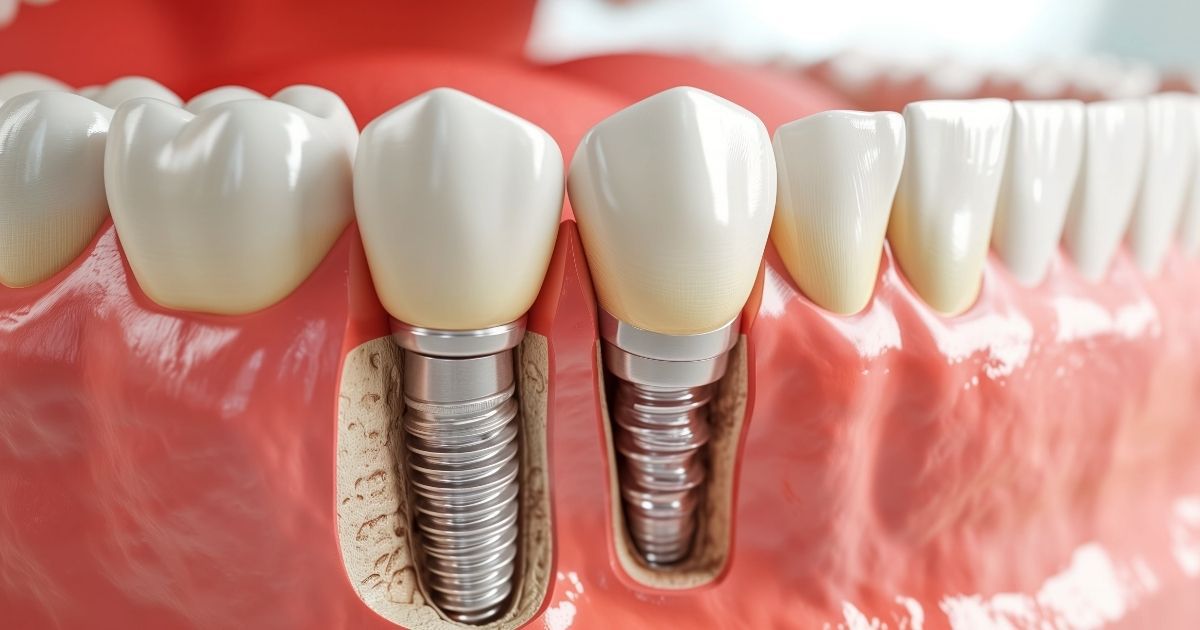Mini dental implants: What you should know
Learn everything you need to know about mini dental implants, including what makes them different from standard implants.
But a missing tooth doesn’t have to affect your health or confidence – there are several common tooth replacement options that can restore a full smile.
Mini dental implants are one of those options, and they’re increasingly popular for a range of reasons. We’re here to explain everything you need to know about them, including what makes them different from standard dental implants.
Reading time: 4 minutes

What are mini dental implants?
Mini dental implants are a smaller form of standard dental implants. They’re used for the same reason – as a temporary or permanent replacement solution for missing teeth – but offer some unique benefits over their traditional counterparts:
- These benefits are mostly down to the smaller size. Mini dental implants are one-piece screws that are less than 3mm in diameter, as opposed to standard dental implants which are made up of two pieces and can range from 3.25mm to 5mm in diameter.
- Thanks to their smaller size, the procedure of placing mini dental implants is less invasive than with standard implants. It often only involves one visit under local anaesthesia, as opposed to the two plus visits typical of the standard dental implant procedure.
- They’re also able to be used where standard dental implants can’t be, like for patients who don’t have the required jawbone density to support the larger implant’s size or in cases where implants need to fit into narrow gaps.
For these reasons and more, mini dental implants are growing in popularity as an alternative to other tooth replacement methods, like dental bridges or dentures.
How do mini dental implants work?
Mini dental implants work similarly to standard dental implants. An incision is made in the gum at the site of the missing tooth that’s being replaced, and the roughly toothpick-sized implant screws are inserted into those incisions and secured to the jawbone. The replacement tooth is then attached to the top of the implant screw to sit above the gumline.
However, there are some key differences between the process for inserting mini dental implants compared to standard dental implants. Most importantly, there’s generally no need for dental bone grafting to increase the jawbone density, and the less invasive procedure means the whole process is quicker and easier to perform.
The mini dental implant procedure
While the details will vary depending on the specific type of mini dental implants being used and the professional who carries out the procedure, the following outlines the general mini dental implant process step-by-step:
- A local anaesthetic is applied to numb the target area
- An incision is made in the gum to accommodate the implant screw
- The implant is inserted into the hole and secured to the jawbone
- The implant is gently tightened to the appropriate level
- A replacement tooth is affixed securely to the implant screw
If you’re having multiple teeth replaced with mini dental implants at the same time, the implant screws will likely all be inserted before the replacement teeth are affixed.
How long do mini dental implants last?
How long mini dental implants last depends on a few factors, including whether they’re being used as a temporary or permanent tooth replacement solution. Generally, though, they can last as long as standard dental implants provided they’re properly cared for.
That means mini dental implants could last for up to 10 years before needing to be replaced. And thanks to the minimally-invasive procedure, replacing them is also generally easier than with standard dental implants.
How much do mini dental implants cost?
The cost of mini dental implants varies depending on lots of factors, including what specific type of implants you’re getting, where in the country you’re getting them, and how many teeth you need replacing. On average, you can expect a single mini dental implant to cost between £500-£1,500.

Dental implants or mini dental implants?
If you’re trying to decide between mini dental implants and traditional implants, there are lots of factors to consider.
- The first thing to consider in your decision-making process is what kind of tooth replacement you need. Mini dental implants are better suited to temporary tooth replacements or permanently replacing missing teeth in narrow gaps. Standard implants are often more appropriate for permanent tooth replacements when there’s sufficient space and jawbone density to accommodate the larger screw.
- It’s also important to know the differences between the standard dental implant procedure and the one used for mini dental implants. The former often requires multiple visits, often over several months, to complete any necessary bone grafts and allow for healing time. The latter is much less invasive and can be completed in a single visit using the procedure outlined above.
- Then, there’s the cost difference. Mini dental implants are generally significantly cheaper than their standard counterparts because they’re both smaller and easier to insert. However, they may need to be replaced more frequently.
Advantages
The main advantages of mini dental implants compared to standard dental implants are:
- A quicker, less invasive dental procedure
- No need for pre-implant bone grafting
- Less time required for post-procedure healing
- Able to be used in narrow gaps and for patients with low jawbone density
- Cheaper on a per-tooth basis
Disadvantages
The main disadvantages of mini dental implants compared to standard dental implants are:
- Less suitable for replacing large teeth, like molars
- Can degrade or require replacement on a shorter timeline
- May not provide as secure a hold for the replacement tooth